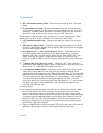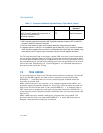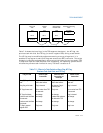
Vol. 3 7-13
TASK MANAGEMENT
• An interrupt or exception vector points to a task-gate descriptor in the IDT.
• The current task executes an IRET when the NT flag in the EFLAGS register is set.
JMP, CALL, and IRET instructions, as well as interrupts and exceptions, are all mech-
anisms for redirecting a program. The referencing of a TSS descriptor or a task gate
(when calling or jumping to a task) or the state of the NT flag (when executing an
IRET instruction) determines whether a task switch occurs.
The processor performs the following operations when switching to a new task:
1. Obtains the TSS segment selector for the new task as the operand of the JMP or
CALL instruction, from a task gate, or from the previous task link field (for a task
switch initiated with an IRET instruction).
2. Checks that the current (old) task is allowed to switch to the new task. Data-
access privilege rules apply to JMP and CALL instructions. The CPL of the current
(old) task and the RPL of the segment selector for the new task must be less than
or equal to the DPL of the TSS descriptor or task gate being referenced.
Exceptions, interrupts (except for interrupts generated by the INT n instruction),
and the IRET instruction are permitted to switch tasks regardless of the DPL of
the destination task-gate or TSS descriptor. For interrupts generated by the INT n
instruction, the DPL is checked.
3. Checks that the TSS descriptor of the new task is marked present and has a valid
limit (greater than or equal to 67H).
4. Checks that the new task is available (call, jump, exception, or interrupt) or busy
(IRET return).
5. Checks that the current (old) TSS, new TSS, and all segment descriptors used in
the task switch are paged into system memory.
6. If the task switch was initiated with a JMP or IRET instruction, the processor
clears the busy (B) flag in the current (old) task’s TSS descriptor; if initiated with
a CALL instruction, an exception, or an interrupt: the busy (B) flag is left set.
(See
Table 7-2.)
7. If the task switch was initiated with an IRET instruction, the processor clears the
NT flag in a temporarily saved image of the EFLAGS register; if initiated with a
CALL or JMP instruction, an exception, or an interrupt, the NT flag is left
unchanged in the saved EFLAGS image.
8. Saves the state of the current (old) task in the current task’s TSS. The processor
finds the base address of the current TSS in the task register and then copies the
states of the following registers into the current TSS: all the general-purpose
registers, segment selectors from the segment registers, the temporarily saved
image of the EFLAGS register, and the instruction pointer register (EIP).
9. If the task switch was initiated with a CALL instruction, an exception, or an
interrupt, the processor will set the NT flag in the EFLAGS loaded from the new
task. If initiated with an IRET instruction or JMP instruction, the NT flag will reflect
the state of NT in the EFLAGS loaded from the new task (see
Table 7-2).


















